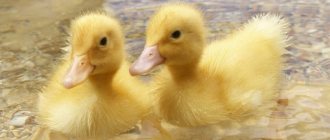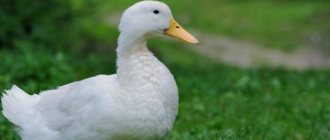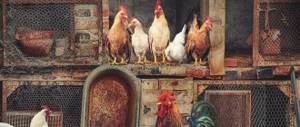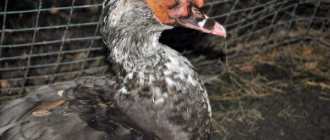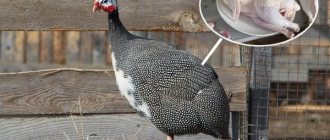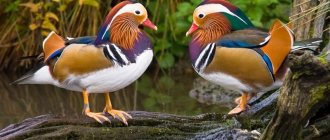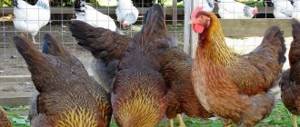General impression
AppearanceFeatures of breeding and cultivationProductivity
Khaki Campbell ducks are small in size. The body is slightly oblong and has a horizontal position. The length is 55-65 cm.
The head is round and medium in size. The beak is green. Dark brown eye color. The neck is straight, thin, short.
The back and chest are narrow. Wings and tail are medium in size. Plumage color ranges from brown to khaki. The limbs are short and strong. The duck's feet are brown, while the drake's feet are dark orange. The drake also differs from the female in the dark brown color of its head plumage.
The plumage of ducklings is khaki, only more spotted than that of adults.
Birds are well suited for breeding in poultry farms, farms and households. They are distinguished by activity, energy and friendliness, the herd feeling is well developed, so the birds always stay together.
Due to underdeveloped wings, the ability to fly is lost.
Females begin to lay eggs at 6 months. The survival rate and hatchability of ducklings is high - up to 80% . For hatching eggs, a parent flock of 10 ducks and one drake is usually created. Eggs from laying hens are taken for incubation from the second year of egg production.
Advantages:
- high and long-term egg production;
- high meat productivity;
- adaptation to different climatic conditions;
- unpretentiousness to maintenance and nutrition.
Flaws:
- requires a lot of space for walking.
The orientation of the breed is meat and egg. Egg production from one female averages 300 eggs per year. The egg weighs 70-80 g, contains B vitamins, iron, and mineral salts. In addition to high egg production, the breed is famous for its good meat productivity.
The meat of this breed is considered dietary, as it has virtually no fat and has a delicate taste. The meat portion of the slaughter weight is up to 80% .
Males are usually fattened; they are slaughtered when they gain weight of 2.5-3 kg. The main volume is gained at the age of 4 months. Further, the duck's growth slows down.
How to hatch ducklings?
To obtain hatching eggs, a parent flock is created. It may be more numerous than in ducks of other breeds. It includes 10 females and 1 drake. The livestock is kept in a separate pen. Eggs from laying hens begin to be taken for incubation only from the 2nd year of egg production.
They are checked using an ovoscope, cleaned of dust and placed in an incubator. The cabinet maintains a certain temperature and humidity regime. It is not the same at different periods of egg maturation:
- 1 week – the temperature remains at 38 C, 38.2 C is allowed. Humidity is about 70%. If there is no automatic device for maintaining humidity, then install a container of water in the cabinet. Evaporation will increase the humidity in the incubator. Be sure to turn the eggs in different directions. The optimal turning mode is every 3 hours. It is recommended to ventilate the cabinet every day. To do this, open it for 5 minutes;
- Week 2 – the temperature is gradually reduced to 37.8 C. Humidity is also reduced to 60%. Continue turning the eggs and ventilating the cabinet in the same mode;
- Week 3 – only the ventilation mode changes. The time is adjusted to 15 minutes daily.
On day 25 they stop turning the eggs. It is recommended to transfer the material to the excretion chamber. It is a closet, but without shelves or cells for eggs. On day 26, hatching occurs. The humidity in the closet is increased to 80%. This will make the shell looser, which will make it easier for the chicks to work. The ducklings remain in the chamber until completely dry. They wait until all the chicks are born and become fluffy.
Khaki ducklings
The down of ducklings is also khaki, like that of adults, but the color is uneven and spotted. The chicks are transferred to a brooder under a lamp. Withstands temperatures of 30 C, humidity 60%. A mesh floor is made in the brooder. There is a tray underneath, which is cleaned and disinfected daily. Feeders and drinkers are taken outside the walls of the brooder. The chicks can remain in the cage until they are one month old. In the warm season, walking young animals can begin on the 7th day. They are placed in a separate pen.
More on the topic: How are ducks and grebes the same?
The ducklings are fed boiled eggs, cottage cheese, and grain mixtures. The grains chosen are corn, wheat and barley. The grains are ground into flour. For full development, young animals are given bone meal, but not more than 2 g per head, chalk, and table salt. From 2 weeks, gravel is introduced.
Igor Nikolaev
auto RU
If the ducklings are free-range, then they get green grass, which contains many vitamins, themselves. Otherwise, dandelions, nettles, willow leaves, lettuce, and green onions are added to the food. The herb must be steamed and crushed so that it is soft. Ducklings receive chopped hay as roughage.
Content
Birds of this breed are unpretentious and adapt well to any climatic conditions. Enclosures should be closed and spacious at the rate of 1 sq. m for three individuals. For free range, an open pond and a large pasture are required. The parent flock is kept in a separate pen. Newborn chicks need additional lighting and temperature control.
Mulards are birds for one season. Features of maintenance and diet, optimal growing period
Read
Raising turkey ducks at home. A Guide for Beginners and Experienced Poultry Keepers
More details
Types of drinkers for ducks and ducklings. Step-by-step manufacturing instructions
Article
The best feeders for ducks. Choose the right one or do it yourself
Read
Content Features
Indian ducks are easy to care for, so they do not require special housing or nutritional conditions.
The only caveat is that in the case of raising Indian ducks to produce delicious meat, additional feed will need to be introduced into the diet.
Care
If there is no body of water nearby, this will not be a serious problem for them. But, despite the fact that the lack of a natural water source is not critical for these birds, they still need to set up a bathing area. Indian ducks love to splash in the water and preen their feathers.
They must always have access to clean water, otherwise a decrease in productivity may occur.
It is best to keep them outdoors, except in winter. Although they perceive light frosts normally and can take a little walk in the fresh air. Indian Runners tolerate the harsh Russian climate well.
These ducks have a good appetite, so you should not limit their food too strictly. The best option would be an intensive, balanced diet.
Feeding
The Indian Runner is a grazing bird, so this duck loves to find snails or feast on fresh greens while out on the open range.
In the evening you can give Runner whole grains. All this helps to significantly reduce food costs.
It is also necessary to provide the birds with enough liquid to drink. To do this, you can use a small basin or any other container.
The size of the area that will be intended for open walking must be at least 10 m² per duck. It will also be necessary to build a small fence for this area. Otherwise, most of your fresh greens harvest will be eaten.
An additional benefit of free range is that duck excrement can serve as good fertilizer for the garden.
Winter period
During the winter season, when ducks do not have access to fresh greens, Runners should receive a more nutritious diet.
The duck needs to be fed, including: cereals, zucchini, grated beets. Mineral supplements and vitamins also need to be included in the diet.
Duckling food
Feeding ducklings has its own differences. In the first days of life, they need to be fed only yolks, then gradually introduce proteins into the diet.
Small portions of mixed feed soaked in water can be given from the fourth day of life. Ducklings also need fresh greens containing the necessary microelements for their further development: lettuce, dill, cabbage leaves.
Breeding
There are usually no problems with breeding Indian Runners.
The best time to purchase small ducklings is in the spring. This is due to the fact that during the summer period they will finally get stronger and will be better prepared for winter frosts.
For one drake you need to take five females.
Before keeping Indian ducks, you need to decide in advance about the main reason for their breeding. There are two options here: raising a new generation of Indian ducks, or only obtaining eggs.
It is important to remember that female Indian runners are good brood hens, but they need at least two months to raise and raise their ducklings
Feeding
The birds' diet consists of balanced feed, enriched with protein additives and mineral salts. If adults and ducklings are kept free-range, then they receive most of the necessary vitamins naturally.
- Stern
- Recipes
Rating of food for ducks and ducklings
Ready-made feed for ducks. Comparative characteristics and consumption rates
Read
What to feed turkey ducks
How to feed turkey ducks. Feeding standards from birth to slaughter to obtain tasty meat
Read
What to feed mulards
Balanced diet for quick weight gain at home
Read
Feeding ducklings and adult ducks
Feeding meat and egg-laying ducks and ducklings at home. Examples of diets depending on the period
Read
Breed Features
It is known that the poultry farmer dreamed of getting the fawn color of plumage, which was fashionable at that time, but she did not succeed. The color of the new birds was more reminiscent of the color of the uniform of British soldiers, so the selector gave them the name Khaki-Campbell.
What do Khaki Campbell ducks look like?
To date, 4 varieties of duck colors have been formed:
However, females are usually sandy-brown in color. The drakes are distinguished by the dark coloring of their heads.
Breed characteristics
Ducks of this breed are quite light. An adult drake rarely weighs more than 3 kg. The female usually gains weight up to 2.2-2.5 kg. Young animals eat most of their weight by 4 months. At this age, ducklings weigh 1.5-2.5 kg.
The behavior of birds directly depends on the conditions of their detention. If ducks are cramped and there is not enough food, they become aggressive and energetic. If there is enough food and the flock has room to roam, the bird behaves calmly and balanced.
Directionality and egg production of the breed
Khaki-Campbell ducks, despite their low weight, are classified as a meat-egg breed. A distinctive feature of this species is its thin bones. Therefore, almost 90% of the weight is the slaughter weight of the bird.
Females begin laying eggs at 6-7 months. During the season, the owner can collect 2 50-340 large eggs (each 70-80 grams) from one individual.
Diseases
Birds are susceptible to diseases:
- avitaminosis;
- cloacite;
- prolapse of the oviduct in females due to the formation of non-standard eggs.
- Parasites
- Infectious
- Other
Coccidiosis
How to identify the disease and how to treat it? What is important to know about prevention?
Read
Worms
Worms are round worms (helminths) that cause various diseases and, as a result, serious disorders in the body of birds
Read
Aspergillosis
An infectious disease caused by fungi that affects the respiratory organs and leads to the death of the bird
Read
Pullorosis
Pullorosis (typhoid, salmonellosis): description of the disease, symptoms, treatment, preventive measures
Read
Hemophilosis
Contagious runny nose is a dangerous respiratory disease that can lead to the death of the entire livestock
Read
Pasteurellosis
Basic characteristics of the disease, methods of prevention and basic principles of treatment
Read
Marek's disease
What to do when poultry suffers from Marek's disease (neurolymphomatosis, avian paralysis)
Read
Cloacite
Inflammatory disease caused by errors in feeding and keeping poultry
Read
